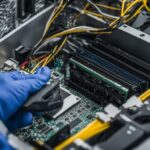IT Recycling solutions: Best Practices and Benefits.
IT Recycling Solutions are becoming increasingly crucial in today’s rapidly evolving technological landscape. Businesses and individuals alike find themselves cycling through IT equipment at an unprecedented rate. While upgrading to the latest hardware is often necessary for staying competitive, it raises a critical question: What happens to the old, outdated equipment? This is where IT recycling comes into play.
The concept of IT recycling involves the responsible disposal of outdated or unwanted IT assets, such as computers, servers, and mobile devices. But it’s not just about getting rid of old equipment; it’s about doing so in a way that is both environmentally sustainable and secure from a data perspective.
The purpose of this article is twofold. First, we aim to educate you on the best practices for IT recycling to ensure that you’re complying with legal requirements while also protecting sensitive data. Second, we’ll delve into the myriad benefits that come with responsible IT recycling, from environmental conservation to potential cost savings.
In the sections that follow, we will discuss the importance of IT recycling, explore the types of equipment that can be recycled, and outline the best practices you should follow. We’ll also highlight the benefits of adopting a robust IT recycling program and provide real-world case studies to illustrate these points. By the end of this article, you’ll have a comprehensive understanding of why and how to implement IT recycling solutions in your organization.
The Importance of IT Recycling
Understanding the importance of IT Recycling is crucial for both businesses and individuals. The practice goes beyond merely disposing of old equipment; it addresses critical issues such as environmental conservation, data security, and legal compliance. Here’s why each of these aspects is essential:
Environmental Impact
The rapid pace of technological advancement means that electronic devices become obsolete quicker than ever before. When these devices end up in landfills, they contribute to environmental degradation by releasing harmful substances like lead, mercury, and cadmium. IT recycling helps mitigate this impact by ensuring that these materials are either properly disposed of or repurposed, reducing the overall environmental footprint.
Data Security
When you dispose of IT equipment, you’re not just getting rid of the physical device but also the data stored on it. Simply deleting files or formatting the hard drive is not sufficient to ensure data security. Proper IT recycling practices include secure data wiping techniques that adhere to industry standards, ensuring that sensitive information—be it personal data or corporate secrets—is completely eradicated.
Legal Compliance
Improper disposal of IT assets can lead to severe legal repercussions. Various laws and regulations govern the disposal of electronic waste, such as the Waste Electrical and Electronic Equipment Directive (WEEE) in Europe or the Resource Conservation and Recovery Act (RCRA) in the United States. IT recycling ensures that you are in compliance with these laws, helping you avoid hefty fines and potential legal action.
Types of IT Equipment that Can Be Recycled
As technology continues to evolve, the types of IT equipment that can be recycled are expanding as well. Recycling is not just limited to consumer electronics like smartphones and laptops; it also includes a wide range of business and enterprise-level equipment. Here are some of the most common types:
Computers and laptops are among the most commonly recycled IT assets. These devices contain various components like motherboards, hard drives, and optical drives that can either be refurbished or harvested for materials. Proper recycling ensures that these valuable components are not wasted and that harmful substances are not released into the environment.
Servers are essential for business operations but can become obsolete as technology advances. These devices often contain high-value materials and components that can be reused or recycled, reducing the environmental impact and conserving valuable resources.
Networking equipment, such as routers, switches, and firewalls, also have recycling potential. These devices contain circuit boards and other electronic components that can be repurposed or recycled, helping to reduce e-waste and conserve natural resources.
Printers and scanners are often overlooked when it comes to recycling, but they too contain valuable materials like metals and plastics. These can be separated and recycled, reducing the need for new raw materials and lessening the environmental impact.
Mobile devices, including smartphones and tablets, are rapidly becoming a significant source of e-waste. These devices contain various metals, including rare earth elements, that can be recovered and reused. Proper recycling ensures that these valuable materials are not lost and that the devices are disposed of responsibly.
Best Practices for IT Recycling Solutions
When it comes to IT Recycling Solutions, there are several best practices that individuals and organizations should follow to ensure both environmental sustainability and data security. These practices are not just about responsible disposal but also about maximizing the value and lifespan of your IT assets. Here’s a closer look at some of these key practices:
Data Wiping
Importance of Data Wiping Before Recycling
Data wiping is a crucial step in the IT Recycling Solutions process. It ensures that all sensitive information is permanently removed from the device before it is recycled or repurposed. Failing to properly wipe data can lead to security risks, including data breaches and identity theft.
Recommended Software and Methods
When it comes to data wiping, using certified software that adheres to industry standards is recommended. Software like DBAN or specialized enterprise solutions can effectively overwrite the data, making it irretrievable.
Choosing a Certified Recycler
Importance of Certification
Working with a certified recycler ensures that your IT assets are recycled in an environmentally responsible manner. Certification bodies like e-Stewards or R2 set standards that recyclers must meet, ensuring both environmental sustainability and data security.
What to Look for in a Recycler
When choosing a recycler, look for certifications, reviews, and whether they follow local and international regulations. Transparency in their recycling process and a track record of responsible practices are also good indicators.
Secure Transportation
How to Ensure Secure Transportation of IT Assets
Secure transportation is another critical aspect of IT Recycling Solutions. Ensure that the recycler you choose has secure transportation methods to prevent any data breaches or theft during the transit process.
What to Look for in a Transportation Service
Look for services that offer GPS tracking, secure containers, and a chain of custody documentation to ensure that your IT assets are securely transported from your location to the recycling facility.
Benefits of IT Recycling
The practice of IT Recycling offers a multitude of benefits that extend beyond the immediate act of recycling or repurposing old equipment. These benefits can be categorized into environmental, economic, and social advantages. Here’s a closer look at each:
Environmental Benefits
Reducing E-Waste
One of the most immediate benefits of IT Recycling is the reduction of electronic waste, commonly known as e-waste. By recycling old and obsolete electronic devices, we prevent them from ending up in landfills, where they can leach harmful chemicals into the soil and water.
Conserving Resources
Recycling IT equipment allows for the extraction of valuable materials like metals and plastics, which can be reused to manufacture new products. This not only conserves natural resources but also reduces the energy required for the production of new materials.
Economic Benefits
Cost Savings
IT Recycling can lead to significant cost savings for businesses. Properly recycled IT assets can be refurbished and resold, reducing the need for purchasing new equipment. Additionally, many jurisdictions offer tax incentives for businesses that engage in responsible recycling practices.
Potential for Revenue from Selling Recycled Materials
Recycling IT assets can also generate revenue. The materials recovered from old equipment, such as copper, aluminum, and rare earth metals, can be sold to manufacturers for reuse, providing an additional income stream for businesses.
Social Benefits
Job Creation
The process of recycling IT equipment can create jobs at various stages, from collection and transportation to refurbishing and reselling. This contributes to economic development and provides employment opportunities in local communities.
Educational Opportunities
IT Recycling can also offer educational benefits. Schools and educational institutions can benefit from refurbished computers and other IT equipment, providing students with the necessary tools for learning. Additionally, the process of recycling can be used as an educational example to teach students about the importance of sustainability and responsible waste management.
Conclusion: The Lasting Impact of IT Recycling
The practice of IT Recycling is not just a trend but a necessity in our modern world. As we’ve seen through various case studies, the benefits are manifold, spanning environmental, economic, and social spheres. From reducing e-waste and conserving valuable resources to ensuring data security and even generating revenue, the advantages of a well-implemented IT recycling program are clear.
Whether you’re an individual or part of an organization, adopting responsible IT recycling practices can have a lasting impact. For more insights into the importance of recycling, you can read this article.
By understanding and leveraging these benefits, we can make more informed decisions about how we manage our electronic waste, contributing to a more sustainable and secure future for all.















